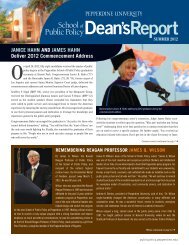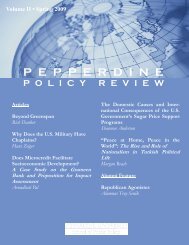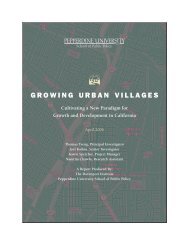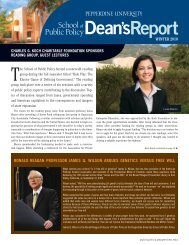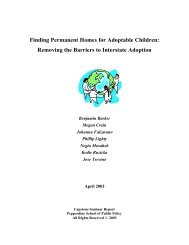Pepperdine University School of Public Policy
Pepperdine University School of Public Policy
Pepperdine University School of Public Policy
You also want an ePaper? Increase the reach of your titles
YUMPU automatically turns print PDFs into web optimized ePapers that Google loves.
<strong>Pepperdine</strong> <strong>Policy</strong> Review Volume I, Spring 2008<br />
Sugar ethanol is another common type <strong>of</strong> ethanol used globally. Sugar ethanol is not<br />
widely in production in the United States but is the main form <strong>of</strong> renewable fuel for Brazil,<br />
which produces it more cheaply and efficiently than the United States produces corn ethanol<br />
(Montenegro). There is currently a tariff on Brazilian ethanol to protect the domestic corn<br />
ethanol market. In general, producing ethanol from sugar cane is less expensive than producing<br />
it from corn because the production process requires fewer steps. Corn must first be broken<br />
down into a starchy sugar and then broken down again to make the alcohol for fuel. Unfortunately,<br />
sugar cane ethanol production in the United States is not economical. The United<br />
States does not have the proper growing conditions for large-scale sugar crops and creating<br />
them artificially would be very expensive.<br />
In terms <strong>of</strong> ethanol production, Brazil has mastered the market. Brazilian use <strong>of</strong> sugarbased<br />
ethanol has replaced more than 40 percent <strong>of</strong> their gasoline consumption and was still<br />
on the rise as <strong>of</strong> mid-2006 (Reel). Brazil has the right to claim reaching “energy independence”<br />
from their ethanol development (Reel). It is crucial to note, however, that “most <strong>of</strong> these policies<br />
were developed over decades, and mistakes were made,” in the process that helped Brazil<br />
arrive at the efficiency it has achieved today (Hester 13). The United States can learn from<br />
some <strong>of</strong> Brazil’s mistakes, but the most important lesson is that moving from an all-gasoline<br />
society to one that incorporates ethanol is a slow process that requires government support.<br />
Brazil began its process in the 1970s with subsidies and financial aid to its ethanol market and<br />
has only decreased these incentives in recent years now that the market has become strong on<br />
its own. Furthermore, now that it has attained energy independence, moving forward is an<br />
even slower process that will require detailed research into the positive and negative consequences<br />
<strong>of</strong> high levels <strong>of</strong> ethanol use (Hester 17).<br />
The final type <strong>of</strong> ethanol addressed in the Energy Independence and Security Act <strong>of</strong><br />
2007 is cellulosic ethanol. Cellulosic ethanol is made from the cell walls <strong>of</strong> starchy plants that<br />
store high levels <strong>of</strong> energy and can be broken down into ethyl alcohol. The plants used in the<br />
production <strong>of</strong> cellulosic ethanol are referred to as biomass. Biomasses that can be used for the<br />
production <strong>of</strong> cellulosic ethanol in the United States include switchgrass, poplar, willow, wood<br />
pulp, corn stock, among others (USDA). All forms <strong>of</strong> ethanol discussed yield approximately<br />
two-thirds the energy <strong>of</strong> gasoline, but cellulosic ethanol is three times more environmentally<br />
efficient (EIA), meaning it and other alternative energies do not harm the environment. There<br />
are many new alternative fuels, such as corn ethanol and liquid coal, whose production have<br />
serious negative impacts on the environment. Producing cellulosic biomass, however, does not<br />
require the fertilizer and pesticides that corn needs. As discussed later in this article, the costs<br />
<strong>of</strong> these chemicals to the environment are substantial. Cellulosic ethanol in its final form is<br />
chemically the same as conventional ethanol, but is made through a three-step process from<br />
biomass. Experts in the bi<strong>of</strong>uels field are now beginning to point to cellulosic ethanol in increasing<br />
numbers as the answer to fulfilling America’s alternative fuel needs. Cellulosic ethanol,<br />
unlike corn ethanol, will not directly take away from the food market and is overall much<br />
more environmentally efficient. The new House Resolution 6 will require at least 16 billion gallons<br />
<strong>of</strong> the mandated 36 billion gallons to come from cellulosic biomass.<br />
III. Literature Review<br />
Today’s ethanol development is distinct from similar markets <strong>of</strong> the past. Cascone<br />
notes that “globally, bi<strong>of</strong>uels developments are primarily driven by three fundamental policy<br />
considerations: rural development, energy independence, and a reduced carbon footprint” (95).<br />
The reduction <strong>of</strong> the carbon footprint is an unusual motivation for such large and broad policies<br />
globally and generally stems from the moral argument that societies must do something to<br />
combat global warming. Traditionally, changes that occur at a global level have related to po-<br />
18



